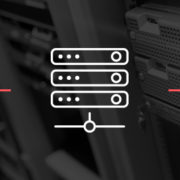A virtual server, or a local one: Which is best for your SMB?
Many companies are now tapping into the power of virtualization for lots of different benefits that it can provide. It’s important to be aware of both the drawbacks and benefits of having a virtualized server for your organization.
From here, you can decide whether or not it will be a good investment for you and your business.
First up: What exactly is server virtualization?
Server virtualization is the process of taking a physical server and partitioning it out to be run in multiple “virtual instances”. A virtualized server can run different operating systems and sessions within a single physical unit.
In plain English – it’s one physical server running multiple digital servers. Typically, these virtual server hosts are housed in a secure off-site facility.
The biggest benefits of server virtualization
Historically, organizations have kept a server or two onsite in a dedicated server room. However, with the advent of virtualization, organizations have quickly picked up on the benefits.
Here they are:
1. A better budget strategy
With a virtualized server, you often only need one server to suffice for your entire organization. That means you can get rid of your CAPEX-reliant on-prem services and shift to a more stable OPEX IT cost strategy.
Besides allowing you to create a more predictable IT budget, you can use the savings to invest more into strategic IT support to handle other technical challenges that may arise.
2. Save time and money
Using virtual servers means you can do without the hours and costs you’d otherwise spend on physical server maintenance, security and upgrades. With virtual servers, you don’t have to worry about taking down the server to do routine maintenance – it’s all handled for you by the organization that manages the server.
In turn, that means you can have your IT department focus on more important IT projects elsewhere in your organization. You’re not wasting their time (and your money) on unnecessary upkeep.
3. Increase your productivity
Virtual servers don’t increase productivity directly. However, they do allow for your staff to connect to data securely from remote location, which does improve productivity. In fact, 56% of businesses say a mobile strategy is very or extremely important to their objectives.
Your staff can connect directly to their files and folders securely without needing complex and expensive third-party software. With increased mobility and accessibility, you’ll see a notable spike in productivity.
4. Improved disaster recovery
Backing up critical data to another server is both quick and efficient with virtual servers.
That’s because host facilities often replicate data between servers to ensure a healthy dose of data redundancy. If they didn’t, they’d be breaking their SLAs that guarantee data availability to a certain level.
Virtual servers are also highly compatible with disaster recovery tactics, as they can restore your data from anywhere in the world. Even if your physical workspace is destroyed, you can rest easy knowing that your data is safe in an off-site virtual server.
What are the cons to virtualized servers?
There may be higher upfront costs to budget for when implementing a virtualized server system. Remember, unless you’re running a proprietary on-site virtual server, you’re likely using a base system that exists. That translates to a licensing fee, plus storage costs.
Security can both be a pro and a con. With an off-site virtual server, you’ll need to take additional precautions to secure your data as it travels to and from your network. This is something that those with local, on-prem physical servers don’t really need to worry about.
Traditional on-prem servers have been around for a lot longer, and will, therefore, be more familiar to operate for technicians. Virtual servers are a bit different, which can pose a slight learning curve to those that aren’t up-to-date with modern server practices
Virtual or local on-prem servers?
Granted, it’s a tough choice.
One gives access to a slew of great benefits but requires more technical know-how. The other is a traditional business IT staple, but can somewhat limit your organization.
Here’s the trick to getting the best choice for you:
Find a company who understands your business goals. Talk to them about your business goals – from there, they can guide you on what’s most effective for you (and what fits best into your IT budget).
Of course, you could always give us a shot. We’re experts at all things virtualization. We can help you boost your efficiency while cutting costs and embracing the future. Sound like a good idea?
Reach out to us. We’re always happy to chat.











